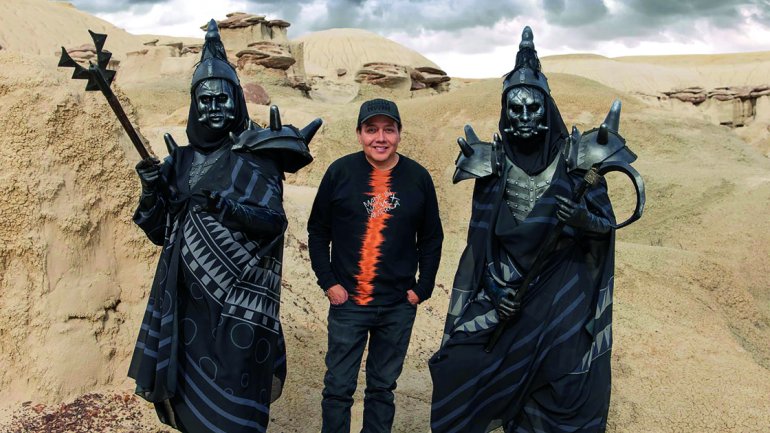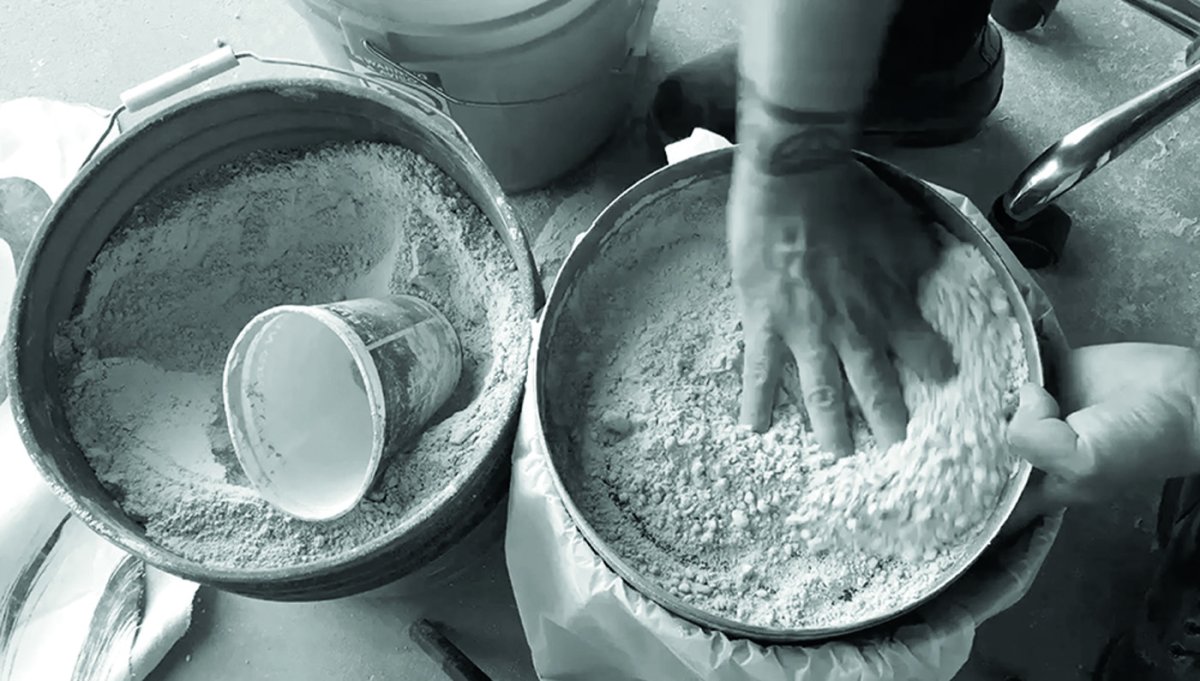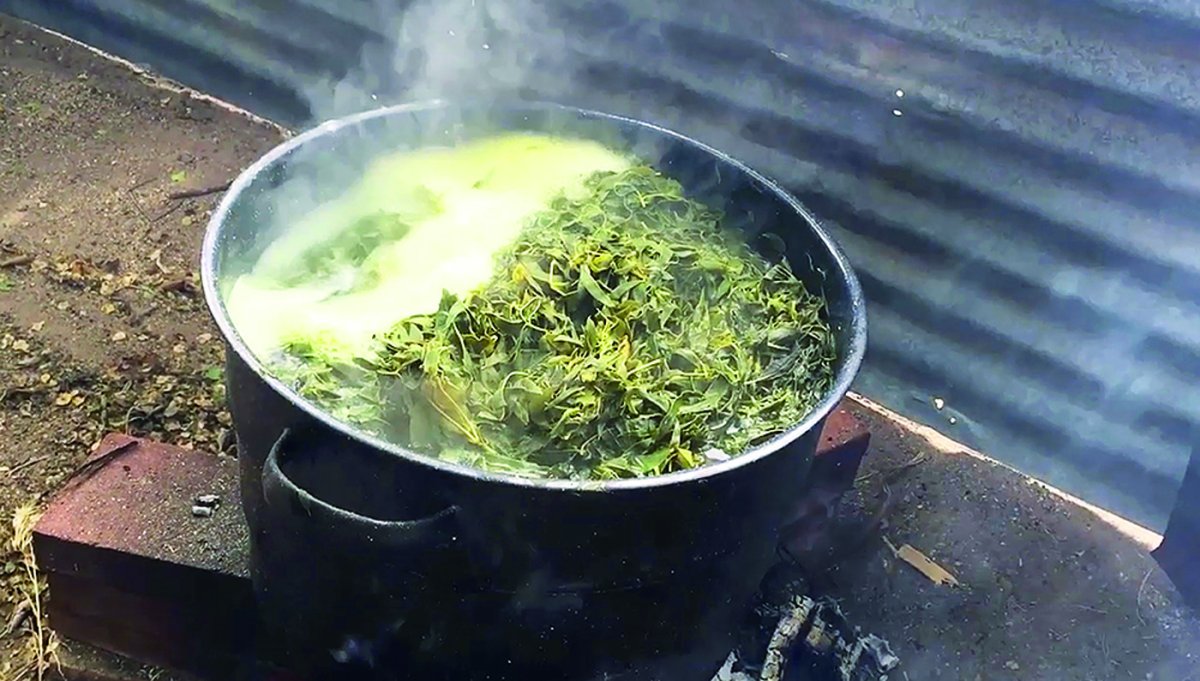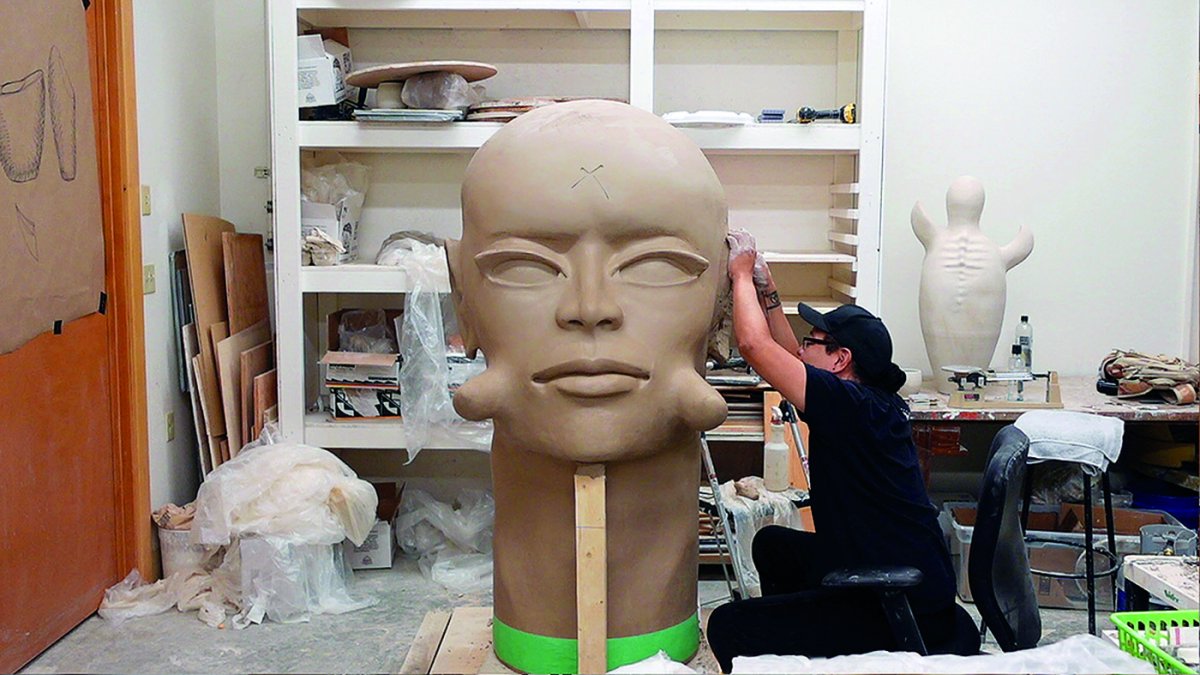The Ceramist and the Superheroes
The Ceramist and the Superheroes
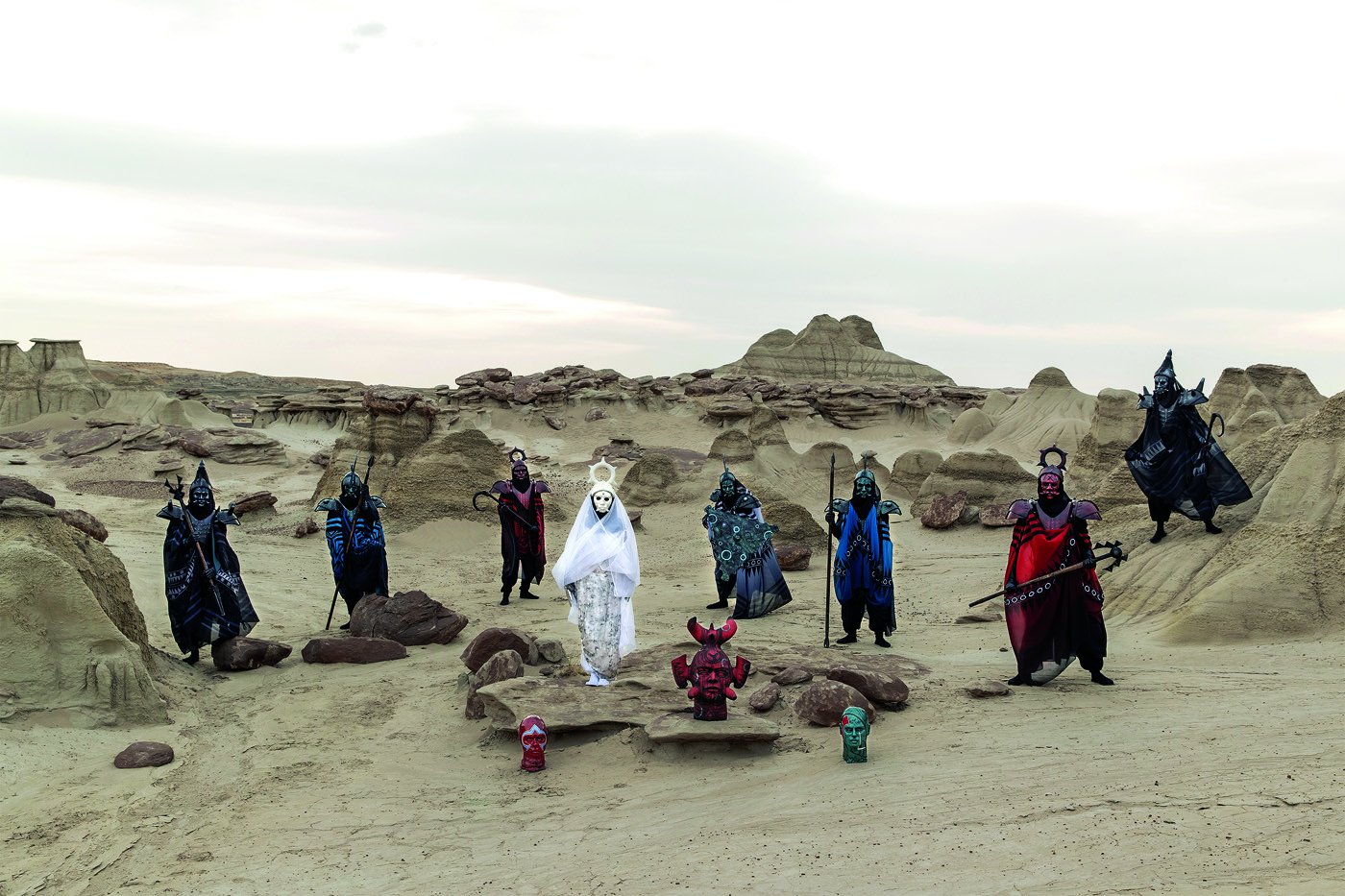
Ortiz's Recon Watchmen keep watch over the past, present, and future of the Pueblo peoples in New Mexico. In the foreground are a red bust called Mopez, 2022, 28 x 23 x 16 in., and two smaller sculptures, Grus and Corvis, 2021, made in collaboration with bead artist Elias Jade Not Afraid (Apsáalooke). Photo by Kamden Storm.
When dug out of the earth, the clay at Cochiti Pueblo, New Mexico, appears reddish brown, the chunks like dusted chocolate truffles. Virgil Ortiz, who was born and lives in this community of the Cochiti people, situated between the cities that Spanish colonizers named Albuquerque and Santa Fe, has been digging into this rich earth since his childhood. As did his ancestors before him, the 53-year-old shapes the harvested clay into pottery pieces, only his have a distinct sci-fi bent: striking vessels in black and creamy white carry faces of imagined nomads in gas masks, surrounded by geometric designs of traditional Cochiti potters; majestic sculptures immortalize fictionalized warriors in futuristic regalia. Creating these time-bending artworks is a way for Ortiz to record stories and traditions. In carrying forth this knowledge, he also affirms the strength of Cochiti Pueblos in the wake of the Spanish invasions and ongoing settler-colonialism.
“Clay is Earth Mother,” Ortiz says. “It gives me the opportunity to have a voice. When I talk about any subject matter, whether past, present, and even future, it’s a prayer to make sure that story stays alive.” For the past two decades, the topic that has preoccupied Ortiz is the Pueblo Revolt of 1680, an uprising of Pueblos, including the Cochiti, to overthrow the Spanish in what is now New Mexico. Considered the most successful revolt by Native Americans against European colonial powers, it led to 12 years of independence, with Pueblo Indians driving out colonizers who had enslaved them, forced them to convert to Catholicism, and suppressed their ways of life. For Ortiz, the righteous revolution is a story of resilience. “We’re strong,” he says. “We didn’t lose our ways, and we keep not only art, language, but the word of our ancestors alive.”
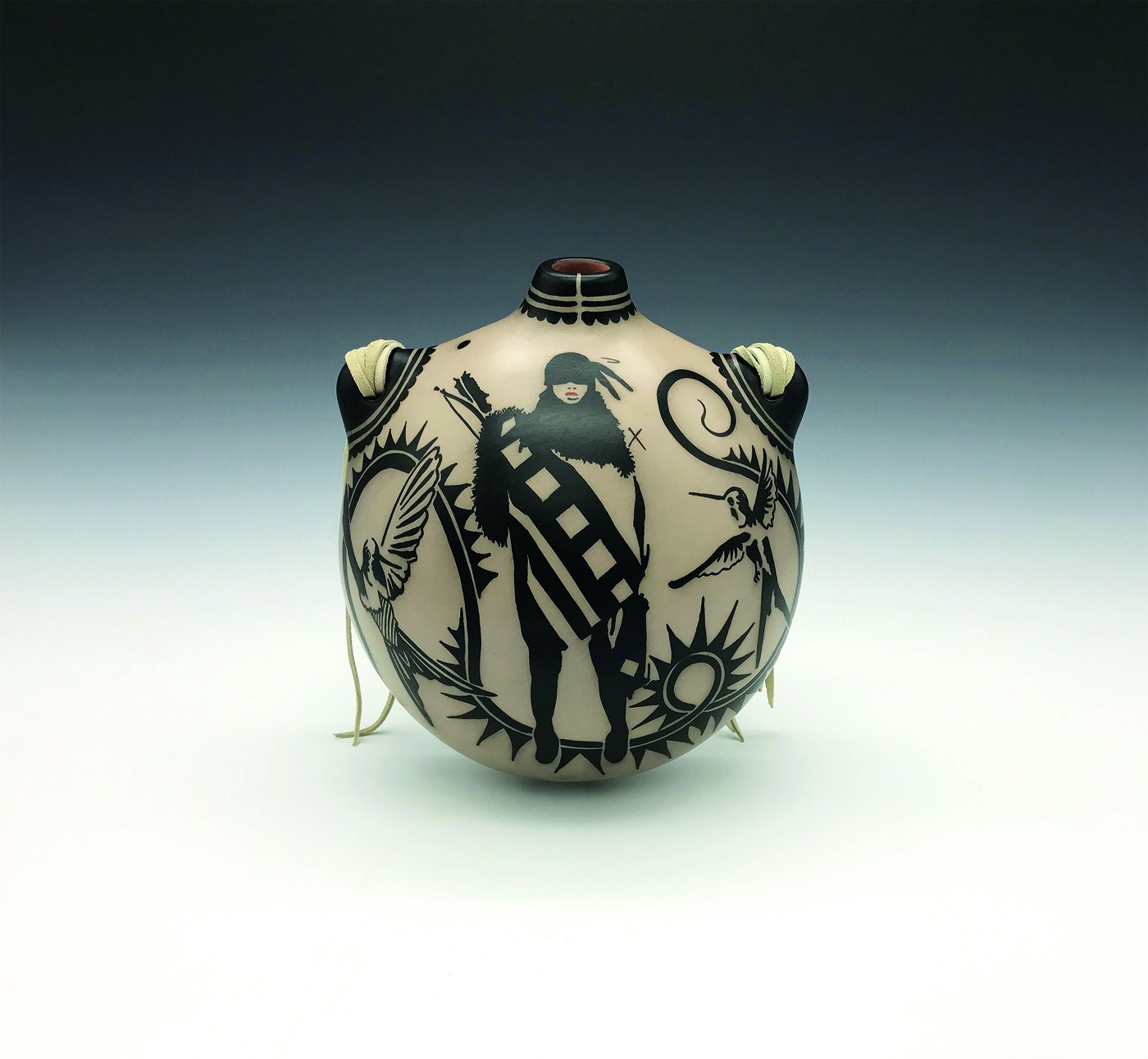
This Cochiti red clay canteen by Virgil Ortiz depicts his character Tahu, leader of the Blind Archers, and is part of his Revolution: Rise Against the Invasion series, 2018, 9 x 9 x 5 in. Photo by Virgil Ortiz.
Across Time
Ortiz’s work keeps the story of the Pueblo Revolt alive, not through mimesis but through constant reinterpretation and reimagining. Each figure he arduously hand-builds is part of a growing cast of characters in an epic narrative he calls Revolt 1680/2180. The tale envisions the world 500 years after the historic uprising, when plunder of Native land is ongoing in a world poisoned by nuclear war. Native soldiers not only square off against the conquering Castilian army; they also time-travel back to 1680 to help their ancestors rise up during the Pueblo Revolt. Their fight is a timeless one: for territory that is rightfully theirs, and for the preservation of their culture and knowledge that is passed through oral traditions and art.
Chief among the heroes of Ortiz’s story is Tahu, a Pueblo matriarch who leads a skilled force of women fighters called the Blind Archers. Ortiz has painted her on several rounded vessels, portraying Tahu at times blindfolded, bow and quiver at the ready, and at times wearing a decorated helmet featuring spikes of feathers. Then there are the Venutian Soldiers, eerie figures armed with staffs and spears, whose faces are hidden by gas masks. As battles wage across centuries, members of the Aeronauts, a band of hunter-preservationists, are tasked with collecting Pueblo culture from the past, including artifacts, artworks, and ceremonial knowledge. All twins, the Aeronauts often appear in Ortiz’s ceramics in pairs, as painted or standalone figures, or as busts with head-to-toe patterning. Guarding this realm are the wide-eyed Recon Watchmen, who surveil the earth—past, present, and future—for enemy movement. Ortiz has created 19 groups of characters to represent the 19 Pueblo nations in present-day New Mexico. Over the years, he has brought them to life not only through clay but also through fashion, video, and installations. With recent solo exhibitions at the Montclair Art Museum in New Jersey, Minneapolis Institute of Art, and Museum of Indian Arts & Culture in Santa Fe, and one forthcoming in 2023 at the newly constructed New Mexico Museum of Art Vladem Contemporary, Ortiz—recipient of the 2022 Museum of Indian Arts & Culture’s Living Treasure Award—is bringing his storytelling to new levels of visibility.
His action-packed narratives have also caught the attention of entertainment company Meow Wolf, which invited him to create an immersive room of Recon Watchmen (made of foam, fiberglass, resin, and mirrors) at its popular House of Eternal Return in Santa Fe. Open since October, the permanent installation will introduce his work to hundreds of thousands, if not millions, of viewers. The exposure is crucial to why he does what he does. “I’m trying to give Indigenous folks superheroes, but also give everybody a lesson in history,” Ortiz says. “It’s not told in schools, it’s swept under the carpet. I’m acknowledging what our people went through, and that it didn’t put a stop to who we are and how we live.”
“I’m trying to give Indigenous folks superheroes, but also give everybody a lesson in history.
Virgil Ortiz
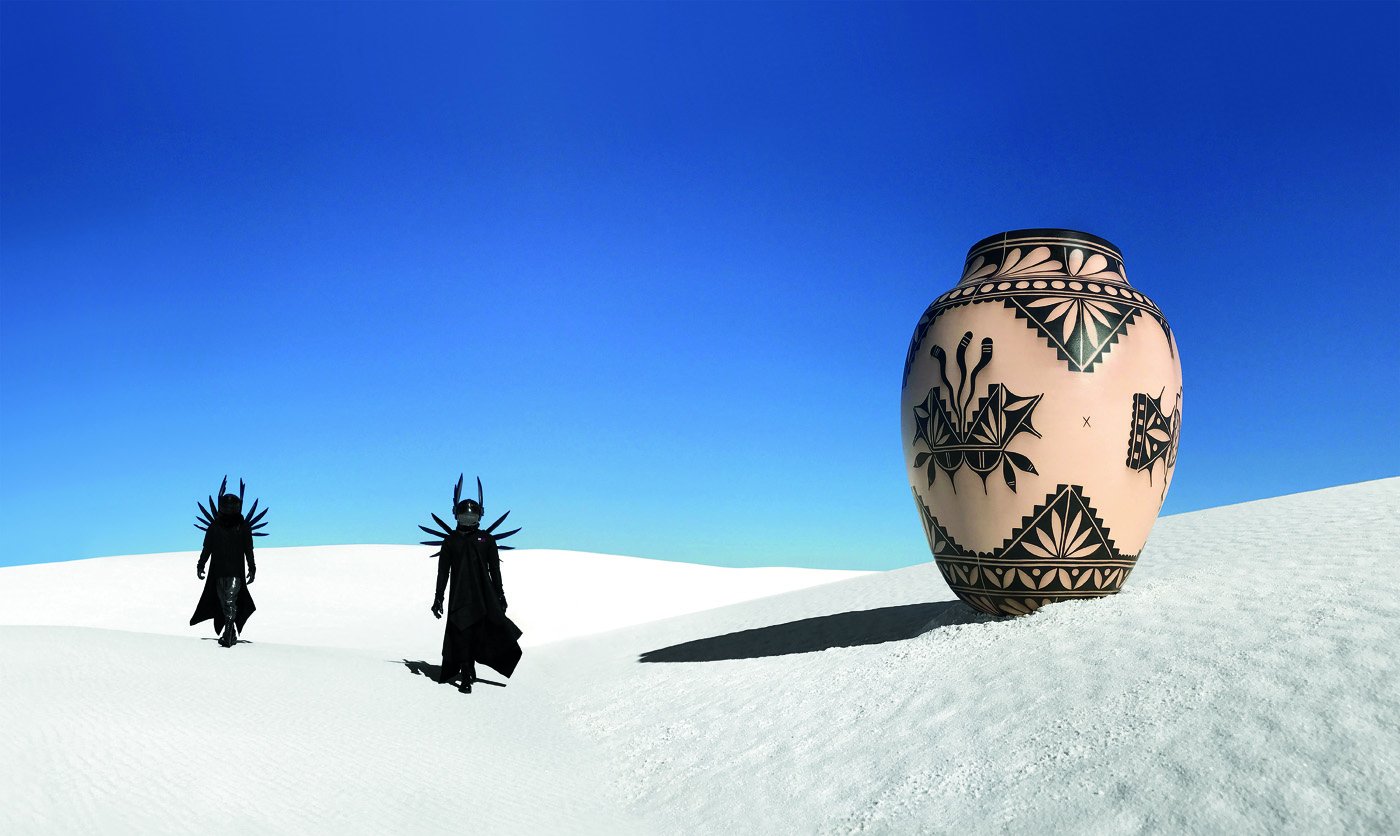
For the past 20 years, Virgil Ortiz has been creating futuristic characters depicted in clay vessels and sculptures, fashion, video, and installations. Here, wearing Ortiz's garments, characters Cuda and Steu, captain and head commander of the Survivorship Armada, collect artifacts for future preservation. On the right is one of Ortiz's Cochiti pottery storage jars, 2018, Cochiti red clay, white clay slip, red clay slip, and wild spinach pigment, 20 x 16 x 16 in. Photographed at White Sands, New Mexico. Photo by Virgil Ortiz.
Ancestral Voices
It’s perhaps no surprise that Ortiz grew up in Cochiti Pueblo consumed by science fiction and fantasy. He watched Star Wars, Star Trek, and Battlestar Galactica, productions that continue to influence him. At the same time, he was immersed in traditional Pueblo art: his father was a drum maker, and his mother, Laurencita Herrera, and grandmother Seferina Ortiz were potters. Virgil, the youngest of six children, remembers waking up and seeing his mother seated at the dining table, creating with clay. His family often made what are known as Storyteller figures—a seated matriarch or an animal holding young ones, the elders appearing to pass on tales. “I would come home after school and be anxious to work with clay next to our mom and grandmother,” he says. “I never knew it was art being created on a daily basis.”
Ortiz was about 15 years old when he began exploring his own style, modeling and painting figures inspired by the action figures from his favorite fantasy franchises. His inventive works caught the eye of Robert V. Gallegos, a family friend and New Mexico art dealer, who invited Ortiz to his gallery in Albuquerque. There, Ortiz and his parents saw a vast collection of historical Cochiti figurative pottery. Known as mono (the Spanish word for monkey), these playful figures were caricatures of white outsiders made in the late 19th and early 20th centuries for a growing tourist market. Many scholars understand them as potters’ social commentaries on a landscape that was changing before their eyes with the arrival of the railroad system. Carrying the traditional Cochiti colors of red, ivory, and black, the mono bore striking resemblance to Ortiz’s own sculptures. “My parents told me, ‘We didn’t even know about these pieces. Remember this day, because it’s like our ancestors were talking to you, and through the clay,’” he says. “I just had a connection I know was built into me. It’s ancestral memory.
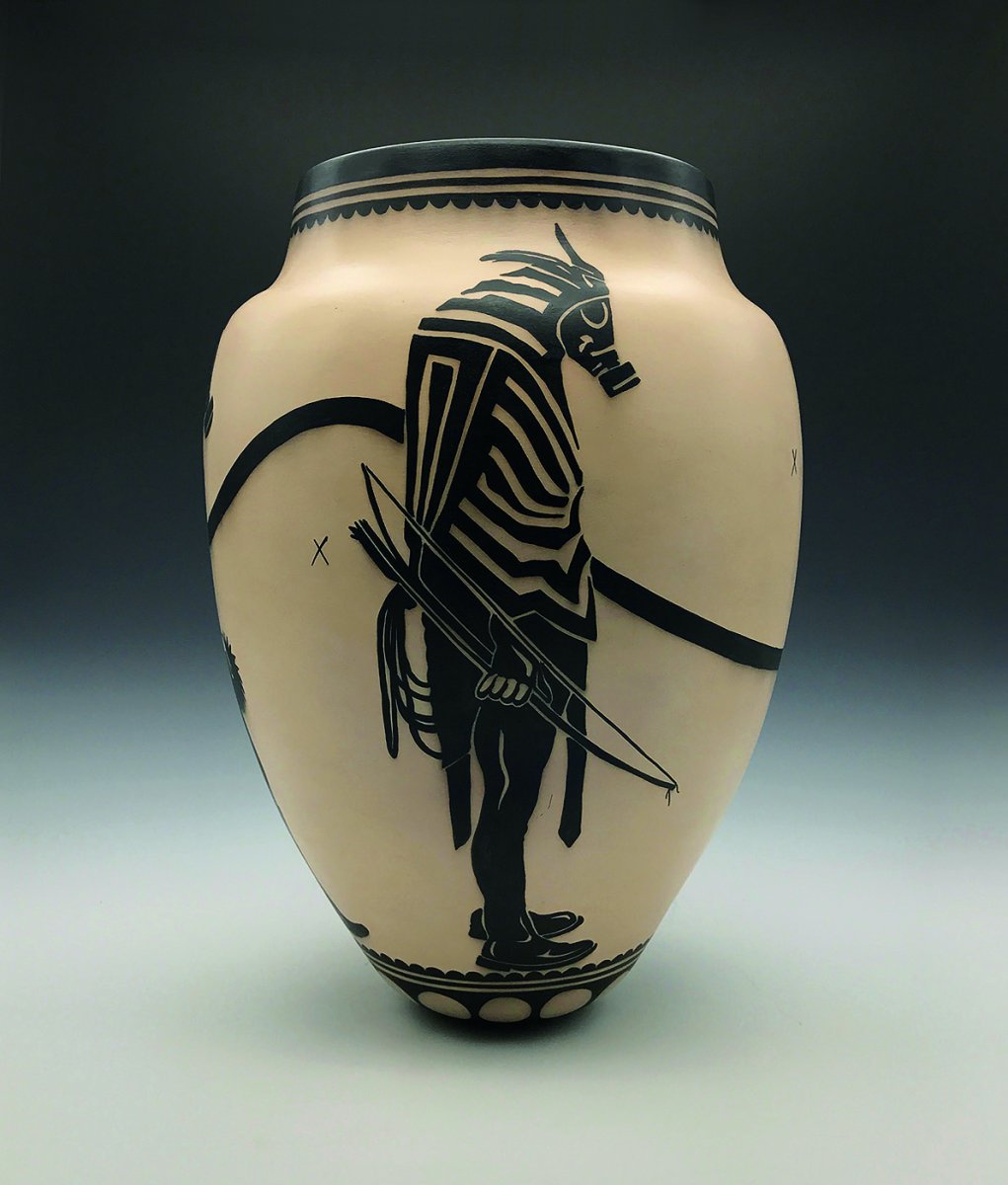
This storage jar, 2018, shows a Venutian soldier wearing a gas mask due to environmental destruction, 17 x 12 in. Photo by Virgil Ortiz.
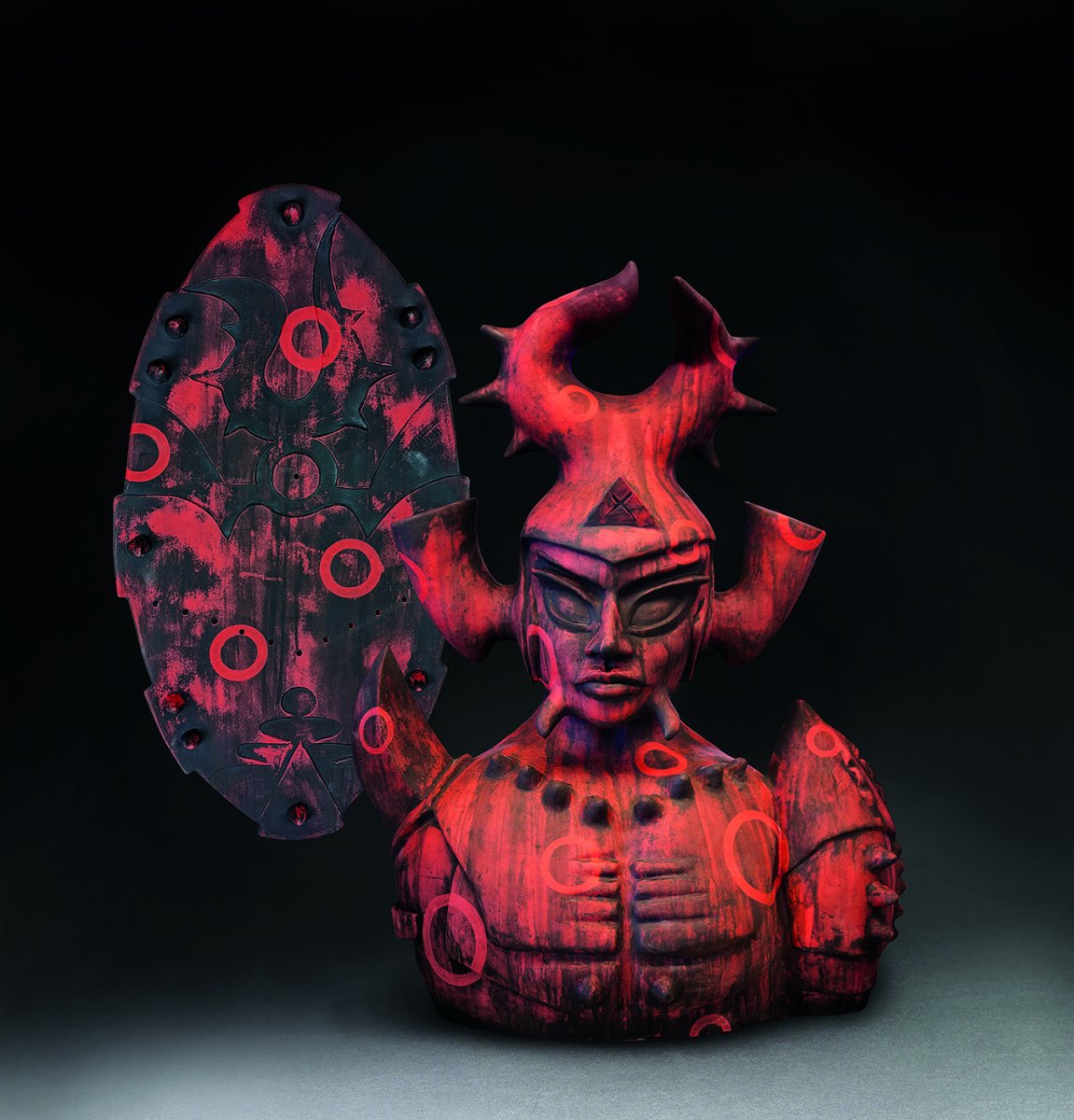
Jai Nopek, 2022, part of the Recon Watchmen series, 41 x 31 x 17 in.; with Ha’pon (war shield), a collaboration with Simon Levin, high-fire clay and glazes, 39 x 21 x 5 in. Photo by Virgil Ortiz.

Ortiz's Sirens: Secret Passkeys & Portals installation at Meow Wolf's House of Eternal Return, Santa Fe.
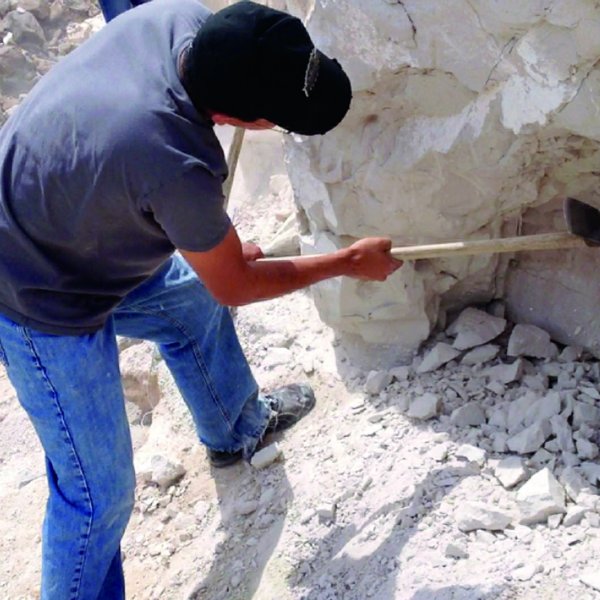
Virgil Ortiz's nephew, Kyle Ortiz, gathers pumice stone, which brings life and strength to the clay. Photo by Virgil Ortiz.
Ancient Methods
Since that visit, Ortiz has only ventured deeper into his imagination. He has built barrel-like vessels with faces of Watchmen in relief; double-spouted water jars painted with the profiles of Stargazers, seers in his expansive universe; wall masks and standing figurines of other characters wearing goggles and respirators. Still, his materials and methods stay rooted in the past. In addition to digging for his clay and using the ancient coil-and-scrape hand-building method, Ortiz prepares his own paint in a process that can span more than a year. The red accents on his pottery are naturally occurring, and the ivory is white slip, but the dramatic black pigment comes from wild spinach that must be picked at its bloom. Ortiz harvests the plant, boils it, then dries the mixture on corn husks. The result can be broken off in pieces, crushed, and rewet into paint.
Ortiz also fires many of his vessels and decorative sculptures the traditional Cochiti way, inside a beehive-like structure of dried cow manure over a scaffolding of chicken wire. Pieces are fired just once, by burning cedar and aspen wood around the sides of the makeshift furnace. “All the oxygen and air and smoke is pulled upward and away from the piece, and you keep adding the fuel until it becomes a huge fireball,” Ortiz says. “All of a sudden the cow manure starts to burn from the outside inward, and that creates our kiln.” After the firing, he rag-polishes the pots, wiping away ashes to reveal the colors, and creating a patina with egg white or animal fat.
According to Ortiz, the process is a dying art, in part because it is so time-consuming. He sees it as his responsibility to help teach other Cochiti artists how to gather and prepare clay—acts that are steeped in ritual and respect for the material. “When we harvest the clay, we have to introduce ourselves, explain our purpose, ask for guidance, for inspiration,” he says, “and we only take as much as we need. We also pay respect to who knows how long our people have been getting clay from this clay bank, and pay homage to what they’ve done and how they’ve paved the road for us.”
To Infinity
In recent years, Ortiz has also been embracing new ways of making. In 2016, his friend Neil Celani, also a ceramist, took him to Santa Fe Clay. It was the first ceramics store Ortiz had ever visited, and it “blew my mind,” he says. “It was like being in a candy store, to see all the different types of tools and all the clay and colors all prepped and ready to go.” He began experimenting with high-fire clay and broadened his tricolor palette, painting entire busts in colors like bright red and teal, incorporating subtle textures, and experimenting with metallic finishes.
He’s also been building bigger since being exposed to different kiln types, such as an anagama wood kiln built by his friend Simon Levin, an Illinois artist. In 2021, Ortiz was in residence at the Archie Bray Foundation for the Ceramic Arts, where he had access to gas kilns, wood kilns, electric kilns, soda kilns, and a salt kiln. The scale of these ovens allowed him to build bigger than he ever had. Ortiz made sculptures in the round up to five feet tall, including a standing Watchmen figure with a cocoon-like body, and several busts of steely-eyed Watchmen with elaborate headpieces. Finished with high-fire glazes, they look like relics, only with the visual pop of action figures—ageless artifacts sent from the future.
“When we harvest the clay, we have to introduce ourselves, explain our purpose, ask for guidance, for inspiration, and we only take as much as we need.”
Virgil Ortiz
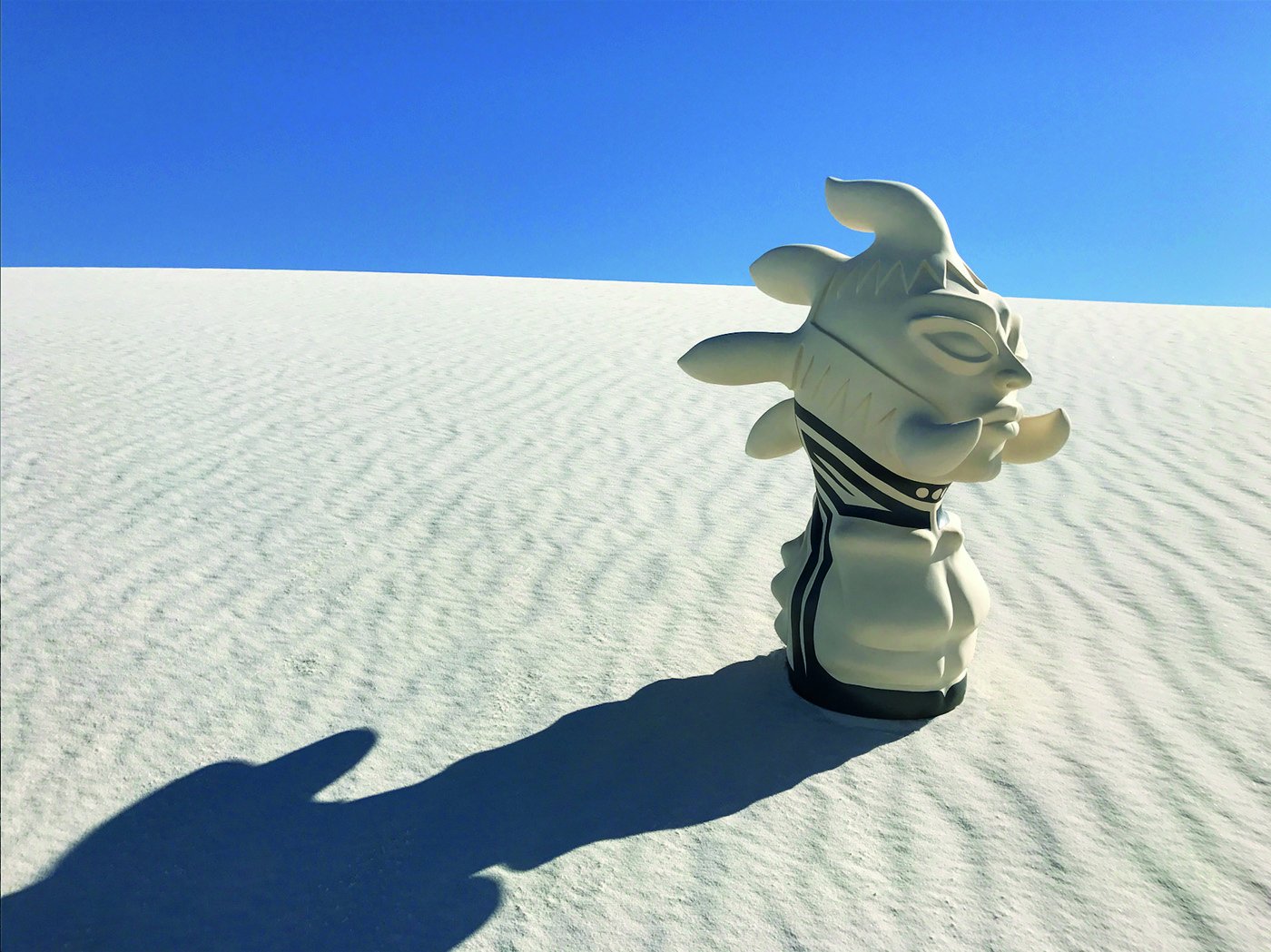
Thunder from the Watchman Series, 2016, high-fire clay, gunmetal acrylic detail, 27 x 14 x 19 in. Photo by Virgil Ortiz.
Ortiz identifies his works as Indigenous futurism, a term coined by the Anishinaabe cultural critic Grace Dillon to describe a movement of narratives—unbounded by time and space—that assert Indigenous sovereignty. The artist defines it simply: “storytelling that connects the past, present, and future. [My work] is an awakening of the truth and education of our history and actual events.”
This idea of an infinity of timelines—and with it, infinite ways of enduring—pushes him to keep inventing. Ortiz has designed garments for his characters, created videos, and written a screenplay for Revolt 1680/2180, which he is trying to make into a movie.
Through it all, he continues to communicate with his family through clay, including those he calls his “best teachers”—his grandmother, mother, and father. “Even though they’re in the next dimension, I still get messages from them,” Ortiz says. “I know they’re very proud, but I know that it’s not my talent, it was just lent to me to talk about our history. Traditional clay will always be the heart and soul—the nucleus—of everything that I do.”◆


